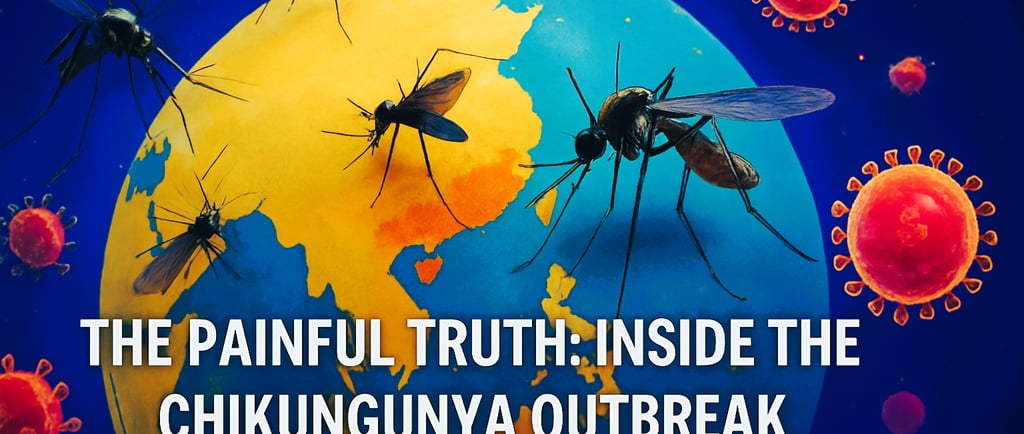The Painful Truth: Inside the Chikungunya Outbreak Sweeping Southern China
Explore the Chikungunya outbreak hitting Southern China. Learn its symptoms, causes, and how to stay protected from this painful mosquito-borne virus.
HEALTH NEWS
8/6/20254 min read


Heard the latest health buzz? It's not the one we've all become too familiar with. This time, the spotlight is on Chikungunya, a virus causing significant concern, particularly in Southern China. The name itself, derived from the Kimakonde language, hints at the suffering it inflicts: "to become contorted." A rather apt description, as you'll soon discover.
At its core, Chikungunya is a mosquito-borne illness, spread by those ubiquitous Aedes mosquitoes – Aedes aegypti and Aedes albopictus – the same vectors responsible for Dengue and Zika. Southern China, specifically Foshan in Guangdong province, finds itself grappling with its most significant outbreak to date, reporting over 7,000 cases. A figure that casts a long shadow on a region where local transmission was once a rarity.
The narrative of Chikungunya is one of global migration. Its origin story begins in Tanzania, Africa, back in 1952. For years, it remained largely confined to Africa, cycling through non-human primates, and Asia, where it established an urban human-mosquito cycle. We saw urban outbreaks emerge in Thailand (1967) and India (1970s). However, the virus underwent a rather unsettling transformation post-2004.
This "glow-up," if one dares call it that, involved viral adaptations that facilitated easier spread, especially via Aedes albopictus. The Indian Ocean Epidemic of 2004-2006 serves as a stark reminder of its potential, with one-third of Réunion Island infected and thousands succumbing to the illness. The virus then set its sights on the Americas, arriving in St. Martin around 2013 and swiftly infiltrating nearly 50 countries, resulting in millions of suspected cases. As of today, Chikungunya has been reported in over 110 countries – a testament to its ability to traverse continents and exploit vulnerabilities.
China's present predicament raises crucial questions. Why this surge, and why now? The answers, it seems, lie in a confluence of factors. Firstly, a largely immunologically naive population in mainland China, unexposed to the virus, presents fertile ground for transmission. Secondly, the region has experienced heavy rainfall and flooding, inadvertently creating ideal breeding conditions for Aedes mosquitoes.
The disease manifests as a sudden high fever, often exceeding 102°F. The hallmark symptom, however, is the intense, often debilitating joint pain, which frequently affects the arms and legs in a symmetrical fashion. This crippling pain is accompanied by muscle pain, headache, nausea, fatigue, and a rash – a rather unpleasant cocktail of symptoms. What's particularly disconcerting is that the joint pain can persist for weeks, months, or even years in some individuals, casting a long shadow on their quality of life. While deaths are rare, newborns, the elderly, and those with underlying health conditions, such as diabetes or heart disease, are particularly vulnerable.
Transmission primarily occurs through the bites of infected mosquitoes. Direct person-to-person transmission is rare, though instances of transmission via blood transfusions or from mother to child during birth have been documented.
China's response has been swift and comprehensive. Adopting measures reminiscent of the COVID-era, authorities have implemented mass insecticide spraying, distributed mosquito nets, and conducted door-to-door inspections to eliminate standing water. High-tech interventions, such as drone surveillance to identify breeding sites, have also been deployed, alongside the release of "elephant mosquitoes," whose larvae prey on the virus-carrying mosquito larvae. Infected individuals may be quarantined in hospitals under nets, and the U.S. CDC has issued a Level 2 travel alert for Guangdong province, advising travelers to exercise caution.
Yet, despite these efforts, challenges and controversies persist. Chikungunya's symptoms often mimic those of Dengue and Zika, leading to potential misdiagnoses. This diagnostic ambiguity underscores the need for heightened vigilance, especially given that the same mosquitoes transmit all three viruses. Furthermore, the historical record is not without its ambiguities. Some experts have suggested that past "dengue" outbreaks in the Americas may have actually been cases of Chikungunya, raising questions about the true historical prevalence of the virus.
Treatment options remain limited, as there is no specific antiviral drug for Chikungunya. Management focuses on alleviating symptoms through rest, fluids, and pain relievers. The diagnostic uncertainty adds another layer of complexity. If Dengue cannot be ruled out, common pain relievers like NSAIDs (ibuprofen, aspirin) are contraindicated due to the risk of bleeding. Acetaminophen becomes the preferred option in such cases.
Vaccine development has yielded some progress, with two vaccines, Ixchiq and Vimkunya, approved for at-risk groups, such as travelers. However, Ixchiq, a live-attenuated vaccine, has raised safety concerns, prompting the CDC and FDA to advise older adults (60+) to delay vaccination due to reports of serious neurological and cardiac side effects, including fatalities. European regulators are also scrutinizing these reports, and the vaccines are not yet widely available in the regions where they are most needed.
Looking ahead, the path forward requires a multifaceted approach. Researchers are actively exploring cutting-edge mRNA vaccines and other viral vector vaccines, mirroring the approaches used in COVID-19 vaccine development. The goals are clear: safer, more effective, and widely accessible vaccines that offer long-lasting protection and are suitable for diverse populations, including pregnant or immunocompromised individuals.
The search for a cure continues, with scientists focusing on targeted therapies involving small molecules and RNA interference technology to directly combat the virus. Repurposing existing drugs for Chikungunya activity is also being explored, alongside the development of monoclonal antibodies for both prevention and treatment.
Ultimately, addressing Chikungunya requires global unity and an integrated approach. This entails combining vaccination, rapid diagnosis, effective symptom management, and aggressive mosquito control strategies. In a world increasingly shaped by climate change and urbanization, the virus is likely to continue its spread. International collaboration is essential to anticipating and mitigating future outbreaks.
So, stay informed, particularly if you plan to travel to affected areas. Protect yourself from mosquito bites by using repellent, wearing long sleeves, and using mosquito nets. And consider supporting global health initiatives that are dedicated to combating infectious diseases like Chikungunya. The fight against this "bent-over" virus is far from over, and it requires a concerted effort from all corners of the globe.
📚 Spark imagination and joy in kids aged 4–12!
Get The Dancing Boy – a fun 3-in-1 digital bundle:
📘 Inspiring eBook
🎧 Audio narration
🎵 Original MP3 song
#KidsReads #AudioBook #ParentingWin #StorytimeMagic
Connect
Join us for wellness insights and natural remedies.
Explore
Discover
673-456-7890
© 2025. All rights reserved.
